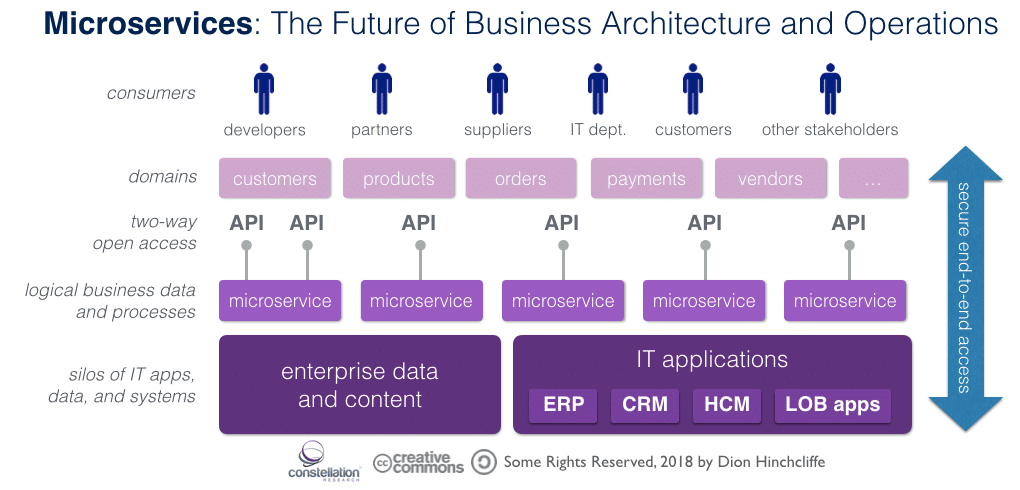Why Microservices Will Become a Core Business Strategy for Most Organizations
- by 7wData

As an industry, we have collectively returned to that eternal debate about what constitutes a largely technical evolution versus when an important digital idea becomes a full-blown Business trend. This has happened before with Web sites, e-commerce, mobile applications, social media, and other well-known advances. It can be hard to remember that at first these were looked at as mostly technology sideshows. Yet they all went on to become serious must-have capabilities on the Business side.
microservices is now a current topic of this debate, as the overall approach is perhaps the most strategic technology trend that’s come along in quite some time. First, a brief definition: microservices provide a well organized digital structuring of our business capabilities that are exposed to stakeholders who need what our organizations can do, and are usually accessed via open APIs. The concept is now poised to — sooner or later — become the primary digital collaboration fabric with all our enterprise data, IT systems, 3rd party developers, business parters, suppliers, and other stakeholders.
So, you read it here first: Microservices are how most organizations will eventually conduct the majority of their business, internally and externally.
Yet there is still considerable debate and confusion about whether microservices are merely just slightly more elegant network plumbing of our digital systems, of if they actually represent the primary conduit for operating our organizations. I fall in the latter camp, as this platform way of thinking in general has steadily emerged as the leading model for composing and integrating networks of systems and organizations. Don’t get me wrong: We had SOA, Web services, and APIs before — where I once posited that this would turn into a global service phenomenon, which it has — but these each had key details missing or not quite right. At this time, microservices does appear to be the best model we have, honed and culled from over a decade of thousands of organizations experimenting with various approaches.
I am now also clearly seeing from many of my CIO and IT contacts that developing a microservices strategy is rapidly becoming a key priority this year. Not sure that this is broadly the case? Just take a look at the recent JAX Enterprise IT priorities survey, which shows that microservices are currently the 3rd leading IT priority, nearly eclipsing the big trend on the block, cloud computing, one of the other hottest IT topics of recent years.
Yet microservices are often conflated with concepts like APIs, for which there is indeed a considerably close relationship, and so can often be relegated to the ‘we’ve been here already’ bin.
Why the sudden popularity and interest in what appears to simply be a more refined technique to easily integrate and communicate between digital systems? For almost all the same reasons that the Business of APIs and the API Economy had their days in the sun: Microservices take so many of the lessons learned in creating more composable, reusable, and platform-centric version of our digital organizations, strips them down to their very basics in terms of design and consumption, and then places them at the very center of how our organizations operate. (Note: Not everyone would agree at the strategic level that microservices should be designed and offered at the business domain or architecture level but many, including myself, do.)
Naturally, the question is why would we do this, and why would it be just about the most important thing we could do to enable a host of vital business activities and outcomes? Put simply, microservices hold the promise of truly unleashing the greatly underutilized assets of our organizations, both strategic and tactical. These assets include everything from data to talent to innovation, and up until now, we’ve been doing it piecemeal and without a real enterprise-wide design (though I’m cautious about overly top-down efforts here as well.
[Social9_Share class=”s9-widget-wrapper”]
Upcoming Events
Shift Difficult Problems Left with Graph Analysis on Streaming Data
29 April 2024
12 PM ET – 1 PM ET
Read MoreYou Might Be Interested In
K is for Knowledge: Application and data integration for better business, using metadata and knowledge graphs
21 Dec, 2019First, you get the software: Operating systems, search engines, browsers, and social networks. Then, you get the hardware: Mobile phones, …
Cloud Native Driving Change in Enterprise and Analytics
22 Sep, 2021A pair of keynote talks at the DeveloperWeek Global conference held online this week hashed out the growing trends among …
Wells Fargo: Artificial intelligence and machine learning a ‘double-edged sword’
10 Sep, 2019Although a bank’s business has basically stayed the same over the last couple of decades, how a bank operates has …
Recent Jobs
Do You Want to Share Your Story?
Bring your insights on Data, Visualization, Innovation or Business Agility to our community. Let them learn from your experience.
Privacy Overview
Get the 3 STEPS
To Drive Analytics Adoption
And manage change




